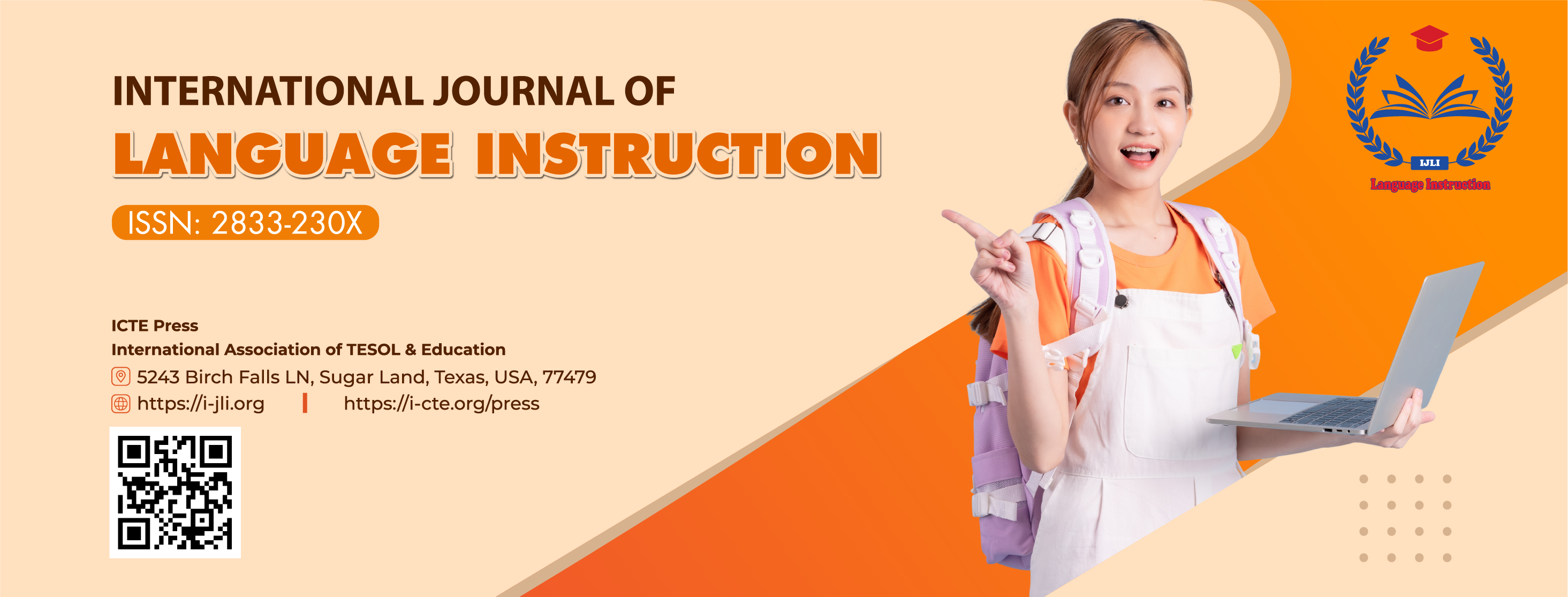EFL Students' Strategies for Learning Academic Vocabulary with Mobile Phones at Van Lang University in Vietnam
DOI:
https://doi.org/10.54855/ijli.23242Keywords:
EFL students, academic vocabulary, AWL appAbstract
This research has investigated how EFL (English as a Foreign Language) students use mobile applications to learn academic vocabulary in a self-directed and autonomous manner. Forty first-year students at Van Lang University taking part in the research process were divided into experimental (N=18) and control (N=22) groups. The experimental group utilized a mobile app throughout the semester, whereas those in the control group used traditional methods. Three final tests every semester were used to check the participants' newly gained vocabulary knowledge. The findings revealed that the students in both groups could enhance their vocabulary proficiency. Nevertheless, the experimental group achieved better results in all three final tests. Moreover, this group also saved significant time when using the phone to support vocabulary learning, while the control group gave unstable test results. The findings demonstrate the potential of mobile apps for independent academic vocabulary acquisition and provide impacts on EFL vocabulary learning.
References
Anderson, R. C., & Freebody, P. (1981). Vocabulary knowledge. In J. Guthrie (Ed.), Comprehension and teaching: Research reviews (pp. 77–117). Newark, DE: International Reading Association.
Bogaards, P., & Laufer, B. (Eds.). (2004). Vocabulary in a second language: Selection, acquisition, and testing (Vol. 10). Amsterdam/Philadelphia: John Benjamins.
Burston, J. (2012). Mobile language learning: Getting IT to work. In J. Burston, F. Doa & D. Tsagari (Eds.), Foreign language instructional technology (pp. 81–99). Nicosia, Cyprus: University of Nicosia Press.
Başoğlu, E.B. and Akdemir, Ö. (2010) ‘A comparison of undergraduate students’ English vocabulary learning: using mobile phones and flash cards’, The Turkish Online Journal of Educational Technology, Vol. 9, No. 3, pp.1–7.
Coxhead, A. (2000). A new Academic Word List. TESOL Quarterly, 34(2), 213–238. https://doi.org/10.2307/3587951
Coxhead, A. (2011). The Academic Word List 10 years on: Research and teaching implications. TESOL Quarterly, 45(2), 355–362. https://doi.org/10.5054/tq.2011.254528
Coxhead, A. (2016a). Reflecting on Coxhead (2000),“A New Academic Word List”. TESOL Quarterly, 50(1), 181-185.
Coxhead, A., & Nation, I. S. P. (2001). The specialised vocabulary of English for academic purposes. In J. Flowerdew & M. Peacock (Eds.), Research perspectives on English for academic purposes (pp. 252–267). Cambridge University Press. https://doi.org/10.1017/CBO9781139524766.020
Cromley, J. G., & Azevedo, R. (2007). Testing and refining the direct and inferential mediation model of reading comprehension. Journal of Educational Psychology, 99(2), 311-325.
Cromley, J. G., Snyder-Hogan, L. E., & Luciw-Dubas, U. A. (2010). Cognitive activities in complex science text and diagrams. Contemporary Educational Psychology, 35(1), 59-74.
Cromley, J. G., Snyder-Hogan, L. E., & Luciw-Dubas, U. A. (2010). Cognitive activities in complex science text and diagrams. Contemporary Educational Psychology, 35(1), 59-74.
Dale, E. (1965). Vocabulary measurement: Techniques and major findings. Elementary English, 42(8), 895–948.
Demouy, V., & Kukulska-Hulme, A. (2010). On the spot: Using mobile devices for listening and speaking practice on a French language programme. Open Learning: The Journal of Open, Distance and e-Learning, 25(3), 217–232. https://doi.org/10.1080/02680513.2010.511955
Eckerth, J., & Tavakoli, P. (2012). The effects of word exposure frequency and elaboration of word processing on incidental L2 vocabulary acquisition through reading. Language Teaching Research, 16(2), 227-252.
Eldridge, J. (2008). “No, there isn’t an ‘academic vocabulary,’ but . . . ”: A reader responds to K. Hyland and P. Tse’s “Is there an ‘academic vocabulary’?”. TESOL Quarterly, 42(1), 109–113. https://doi.org/10.1002/j.15457249.2008.tb00210.x
Evans, S., & Morrison, B. (2011). Meeting the challenges of English-medium higher education: The first-year experience in Hong Kong. English for Specific Purposes, 30(3), 198-208.
Ebadi, S. and Bashidi, S., (2013). Investigating EFL Learners’ Perspectives on Vocabulary Learning Experiences through Smartphone Applications.
Fisher, T., Pemberton, R., Sharples, M., Ogata, H., Uosaki, N., Edmonds, P., . . . Tschorn, P. (2009). Mobile learning of vocabulary from reading novels: A comparison of three modes. In D. Metcalf, A. Hamilton & C. Graffeo (Eds.), Proceedings of 8th World Conference on Mobile and Contextual Learning (pp. 191–194). Orlando, FL: University of Central Florida.
Flowerdew, J. (2015). Some thoughts on English for research publication purposes (ERPP) and related issues . Language Teaching, 48(2), 250 – 262. https://doi.org/10.1017/S0261444812000523
Gardner, D., & Davies, M. (2014). A new academic vocabulary list. Applied Linguistics, 35(3), 305-327.
Godwin-Jones, R. (2017). Smartphones and language learning. Language Learning & Technology, 21(2), 3–17. https://dx.doi.org/10125/44607
Goulden, R., Nation, P., & Read, J. (1990). How large can a receptive vocabulary be? Applied Linguistics, 11(4), 341-363.
Grigoryan, T. (2020). Investigating the effectiveness of iPad based language learning in the UAE context. Open Learning: The Journal of Open, Distance and e-Learning, 1–23. https://doi.org/10.1080/02680513.2020.1718488
Heppt, B., Henschel, S., & Haag, N. (2016). Everyday and academic language comprehension: Investigating their relationships with school success and challenges for language minority learners. Learning and Individual Differences, 47, 244-251.
Huntley, H. (2006). Essential academic vocabulary: Mastering the complete academic word list. Houghton Mifin Company.
Habbash, M. (2015). Learning English Vocabulary Using Mobile Phones: Saudi Arabian EFL Teachers in Focus
Kennedy, C., & Levy, M. (2008). L’italiano al telefonino: Using SMS to support beginners’ language learning. ReCALL Journal, 20(3), 315–330.
Kieffer, M. J., Petscher, Y., Proctor, C. P., & Silverman, R. D. (2016). Is the whole greater than the sum of its parts? Modeling the contributions of language comprehension skills to reading comprehension in the upper elementary grades. Scientific Studies of Reading, 20 (6), 436–454.
Kukulska-Hulme, A., & Shield, L. (2008). An overview of mobile assisted language learning: From content delivery to supported collaboration and interaction. ReCALL, 20, 271–289.
Kramarski, B., & Gutman, M. (2006). How can self‐regulated learning be supported in mathematical E‐learning environments? Journal of Computer Assisted Learning, 22(1), 24-33.
Klímová, B., & Pražák, P. (2019, July). Mobile blended learning and evaluation of its effectiveness on students’ learning achievement. In International Conference on Blended Learning (pp. 216-224). Springer, Cham.
Klimova B., Prazak P. (2018). “Evaluation of the effectiveness of the use of a mobile application on students’ study achievements – a pilot study.” In: Al-Sharhan S. et al. (Eds) Challenges and Opportunities in the Digital Era. I3E 2018. Lecture Notes in Computer Science. 11195, 37-44.
Kacetl, J., & Klímová, B. (2019). Use of smartphone applications in english language learning-A challenge for foreign language education. Education Sciences, 9(3), 179.
Lai, A. (2016). Mobile immersion: An experiment using mobile instant messenger to support second-language learning. Interactive Learning Environments, 24(2), 277–290. https://doi.org/10.1080/10494820.2015.1113706
Laufer, B. (1997). The lexical plight in second language reading: Words you don’t know, words you think you know, and words you can’t guess. In J. Coady & T. Huckin (Eds.), Second language vocabulary acquisition (pp. 2-34). New York, NY: Cambridge University Press.
Laufer, B. (2014). Vocabulary in a Second Language: Selection, Acquisition, and Testing: A Commentary on Four Studies for JALT Vocabulary SIG. Vocabulary Learning and Instruction, 3(2), 38-46.
Lesaux, N. K., Kieffer, M. J., Kelley, J. G., & Harris, J. R. (2014). Effects of academic vocabulary instruction for linguistically diverse adolescents: Evidence from a randomized field trial. American Educational Research Journal, 51(6), 1159–1194.
Le, T. T. D. (2023). Grammatical Error Analysis of EFL Learners’ English Writing Samples: The Case of Vietnamese Pre-intermediate Students. International Journal of TESOL & Education, 3(4), 1–14. https://doi.org/10.54855/ijte.23341
Lu, M. (2008). Effectiveness of vocabulary learning via mobile phone. Journal of Computer Assisted Learning, 24(6), 515–525.
Martínez, I. A., Beck, S. C., & Panza, C. B. (2009). Academic vocabulary in agriculture research articles: A corpus-based study. English for Specifc Purposes, 28(3), 183–198. https://doi.org/10.1016/j.esp.2009.04.003
Meara, P. (1982). Vocabulary acquisition: A neglected aspect of language learning. Language Teaching and Linguistics, 13(4), 221-246.
Nagy, W. E., Herman, P. A., & Anderson, R. C. (1985). Learning words from context. Reading Research Quarterly, 233-253.
Nagy, W., & Townsend, D. (2012). Words as tools: Learning academic vocabulary as language acquisition. Reading Research Quarterly, 47(1), 91-108.
Nation, P. (2001). Learning vocabulary in another language. New York, NY: Cambridge University Press.
Nazari, M., & Xodabande, I. (2020). L2 teachers’ mobile-related beliefs and practices: Contributions of a professional development initiative. Computer Assisted Language Learning, 1–30. https://doi.org/10.1080/09588221.2020.1799825
Nami, F. (2020). Educational smartphone apps for language learning in higher education: Students’ choices and perceptions. Australasian Journal of Educational Technology, 36(4), 82-95.
Ngo, T. C. T. (2021). EFL teachers’ emotion regulation in response to online-teaching at Van Lang University. In Proceedings of the AsiaCALL International Conference (Vol. 533, No. 978-94-6239-343-1, pp. 80-87).
Ngo, T. C. T., & Ha, Y. N. (2022). The integration of English conversation rooms and chatting to enhance English communication skills for EFL students at Van Lang University during the COVID-19 pandemic. International Journal of TESOL & Education, 2(5), 34-63.
Nguyen, H. M. P. (2022). Using Scaffolding to Improve Online Group Presentation in English Literature Classes: An Action Study at Van Lang University. International Journal of TESOL & Education, 2(4), 21-31.
Perin, D. (2013). Literacy skills among academically underprepared students. Community College Review, 41(2), 118-136.
Pham, Q. A. (2023). The English Majored Students' Perceptions of Using Flipgrid in Online Speaking Classrooms. International Journal of TESOL & Education, 3(3), 101-118.
Quiroz, B. G., Snow, C. E., & Zhao, J. (2010). Vocabulary skills of Spanish–English bilinguals: impact of mother–child language interactions and home language and literacy support. International Journal of Bilingualism, 0(0), 1-21.
Schmitt, D., & Schmitt, N. (2005). Focus on vocabulary: Mastering the academic word list. Longman.
Schmitt, D., & Schmitt, N. (2011). Focus on vocabulary 2: Mastering the academic word list. Pearson Education.
Schmitt, N. (2008). Review article: Instructed second language vocabulary learning. Language Teaching Research, 12(3), 329-363.
Song, Y., & Fox, R. (2008). Using PDA for undergraduate student incidental vocabulary testing. ReCALL, 20(3), 290–314.
Thornton, P., & Houser, C. (2005). Using mobile phones in English education in Japan. Journal of Computer Assisted Learning, 21(3), 217–228.
Talan, T. (2020). The Effect of Mobile Learning on Learning Performance: A Meta-Analysis Study. Educational Sciences: Theory and Practice, 20(1), 79-103.
Valipouri, L., & Nassaji, H. (2013). A corpus-based study of academic vocabulary in chemistry research articles. Journal of English for Academic Purposes, 12(4), 248–263. https://doi.org/10.1016/j.jeap.2013.07.001
Wallace, C. (2008). Vocabulary: The key to teaching English language learners to read. Education Digest: Essential Readings Condensed for Quick Review, 73(9), 36-39.
Wells, L. (2007). Vocabulary mastery 1: Using and learning the academic word list. University of Michigan Press.
West, M. (1953). A general service list of English words. Longman, Green&Co.
Wrigglesworth, J., & Harvor, F. (2018). Making their own landscape: Smartphones and student designed language learning environments. Computer Assisted Language Learning, 31(4), 437–458. https://doi.org/10.1080/09588221.2017.1412986
McLean, S., & Kramer, B. (2015). The creation of a new vocabulary levels test. Shiken, 19(2), 1–11. http://teval.jalt.org/sites/teval.jalt.org/fles/19-02-1_McLean_Kramer.pdf
Webb, S., & Nation, I. S. P. (2017). How vocabulary is learned. Oxford University Press.
Downloads
Published
Issue
Section
License
Copyright (c) 2023 Ngo Thi Cam Thuy, Doan Le Anh Thu

This work is licensed under a Creative Commons Attribution 4.0 International License.
The copyright of all articles published in the International Journal of Language Instruction (ijli) remains with the Authors, i.e. Authors retain full ownership of their article. Permitted third-party reuse of the open access articles is defined by the applicable Creative Commons (CC) end-user license which is accepted by the Authors upon submission of their paper. All articles in the ijli are published under the CC BY-NC 4.0 license, meaning that end users can freely share an article (i.e. copy and redistribute the material in any medium or format) and adapt it (i.e. remix, transform and build upon the material) on the condition that proper attribution is given (i.e. appropriate credit, a link to the applicable license and an indication if any changes were made; all in such a way that does not suggest that the licensor endorses the user or the use) and the material is only used for non-commercial purposes.
Authors are able to enter into separate, additional contractual arrangements for the non-exclusive distribution of the journal's published version of the work (e.g., post it to an institutional repository, in a journal or publish it in a book), with an acknowledgment of its initial publication in this journal.











